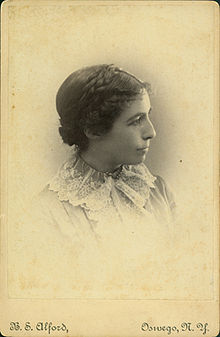Mary Downing Sheldon Barnes (September 15, 1850 – August 27, 1898) was a historian and teacher from the United States. She taught her students how to use primary sources and problem-solving to do their research in college. Anna Strunsky was inspired by Sheldon's work.[1]
Mary Sheldon Barnes | |
|---|---|
 Mary Sheldon Barnes, date unknown | |
| Born | Mary Downing Sheldon September 15, 1850 |
| Died | August 27, 1898 (aged 47) |
| Nationality | American |
| Alma mater | University of Michigan |
| Occupation(s) | Educator Historian |
Early life
changeMary Downing Sheldon was born in Oswego, New York. She had four siblings. She was the oldest of them all. Her mother was named Frances Stiles. Her father was Edward Austin Sheldon. Her father founded Oswego State Normal and Training School. Sheldon would go to school there. She graduated in 1869. She worked there as a teacher for two years. She then went to school at the University of Michigan. She graduated in 1876 with a degree in classics. She went back to Oswego State Normal and Training School where she taught for two years. She taught history, Latin, botany, and Greek. She stopped work at Oswego and started working at Wellesley College in 1876. She worked there for two and a half years. She used case methods in her teaching. She quit working there in 1879 because she was sick and also had problems with the people who worked there. After she quit, she relaxed so she would feel better, and then traveled for fun. In 1882, she went back to work at Oswego. She wrote a book while she was there, called Studies in General History. It was published in 1885.[2]
Teaching and writing career
changeOn August 6, 1885, Sheldon got married. She married a man named Earl Barnes. She met him when he was a student of hers, and he was 11 years younger than her. He became the head of the education department at Stanford University in 1981. Sheldon moved with him and also worked at Stanford. She researched and taught classes about the History of Europe and the Pacific Slope areas. Sheldon and Barnes wrote a book together in 1891. It was called Studies in American History. They also wrote another book in 1896, together. She wrote another book of her own, too. It was called Studies of Historical Method, and taught readers about historical method. In 1897, Sheldon and Barnes quit working at Stanford. They traveled to Europe and wrote while they were there.[2]
Death and afterwards
changeOn August 27, 1898, Sheldon died of heart disease in London. The teaching and writing that she did about research and historical method is considered ahead of its time. The work that she did helped improve history textbooks that are used today.[2] In 1985 and 1986, papers, writings and other materials owned by Sheldon and Barnes were donated to the Sophia Smith Collection at Smith College by Betty Barnes, the daughter-in-law of Earl Barnes, and his second wife, Anna Koehler Barnes.[3]
References
change- ↑ James Boylan (1998). "Revolutionary Lives". Books. New York Times. Retrieved 13 Aug 2011.
- ↑ 2.0 2.1 2.2 "Mary Sheldon Barnes Papers". Sophia Smith Collection. Smith College. 2001. Archived from the original on 15 March 2011. Retrieved 13 Aug 2011.
- ↑ "Mary Sheldon Barnes Papers". Sophia Smith Collection. Smith College. 2001. Archived from the original on 15 March 2011. Retrieved 13 Aug 2011.